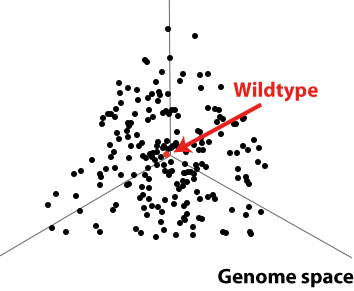Microbial species 3: Quasispecies and ecology

The second main approach to a natural conception of microbial species (by which I mean, as opposed to operational, practical or conventional ones, collectively called "artificial" conceptions) is what I will call the Quasispecies Model. According to the concept developed by Manfred Eigen for viral species, a quasispecies ("as-if-species") is a cluster of genomes in a genome space of the dimensionality the number of loci. A quasipecies is in effect a cloud of genomes, with a "wild-type" coordinate (that is, genome) that may or may not actually have an extant or extinct instance.
A genetic cluster of the quasispecies kind is therefore not unlike James Mallet's Genotypic Cluster Concept (1995), although this is primarily an operational definition than a substantive underlying account of species. We still need to account for quasispecies existing in the first place. We have considered one possible mechanism - gene sharing by lateral transfer - and found it to be insufficient. Is there something else we might make use of?

There is one proposal by Alan Templeton (1989), devised for sexual organisms, which defines a species as a genetic cluster, as Mallet's does, but accounts for it either by genetic exchange, as in the recombination model, or ecological interchangeability. This latter notion is what we might call the "Fitness Peak Conception" of quasispecies.
Each coordinate in genome space, that is to say each genome, has a fitness value associated with it that is imposed by ecological factors. If the adaptive landscape is relatively smooth, which means that adjacent coordinates are correlated in their fitness values, we should expect in the absence of all other causes of clustering that the cloud of genomes will tend to centre upon the most adaptive genome. Of course, this is an abstraction and a gross simplification - genomes are not independent of each other, or from fitness values. Organisms create their ecological conditions to a degree, and how fit a genome is depends also upon what other genomes exist in a population (at least, in sexual organisms), but we can leave these complications to one side for the moment.
So one potential reason why quasispecies exist, why genomes cluster, is that they track local fitness peaks. Let's flesh this out, so to speak. Take a pathogen that is clonal. It needs to employ certain features of the host species in order to infect and exploit that host. Assuming these don't change - say they are recognition molecules on a cell surface - the quasispecies will cluster about those point in the genome space that are more effective than others with respect to the capacity to infect and exploit.
So now we have the two cohesion mechanisms proposed by Templeton - cohesion due to shared genes, and cohesion due to the need to exploit the environment better than competitors. Anything that can do well at the latter will tend to be better represented in the average population. Hence quasispecies.
But fitness peaks typically do not remain constant or decoupled from the populational structure, as I said. Does this mean that quasispecies are not real species because they are ephemeral? Of course not - all species are, over a suitably extended timescale, ephemeral. That is in the nature of evolution. What the fitness peak conception means is that a quasispecies will remain homogeneous so long as there is a more or less unitary fitness peak. If the peaks shift, there will be "speciation". Oh heck, let's stop the pretense that quasispecies aren't real species. There will be real speciation.
In the next blog, I will discuss a way to bring these two notions together, and to link quasispecies with biospecies (sexual species).
Eigen, Manfred (1993), "The origin of genetic information: viruses as models", Gene 135 (1-2):37–47.
——— (1993), "Viral quasispecies", Scientific American July 1993 (32-39).
Mallet, J (1995), "The species definition for the modern synthesis", Trends in Ecology and Evolution 10 (7):294-299.
Templeton, Alan R. (1989), "The meaning of species and speciation: A genetic perspective", in D Otte and JA Endler (eds.), Speciation and its consequences, Sunderland, MA: Sinauer, 3-27.




<< Home